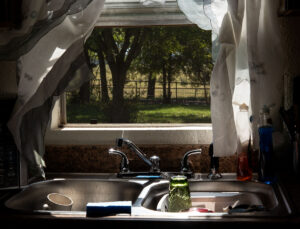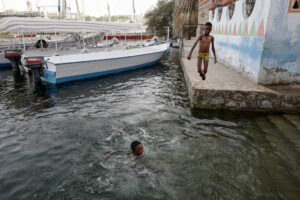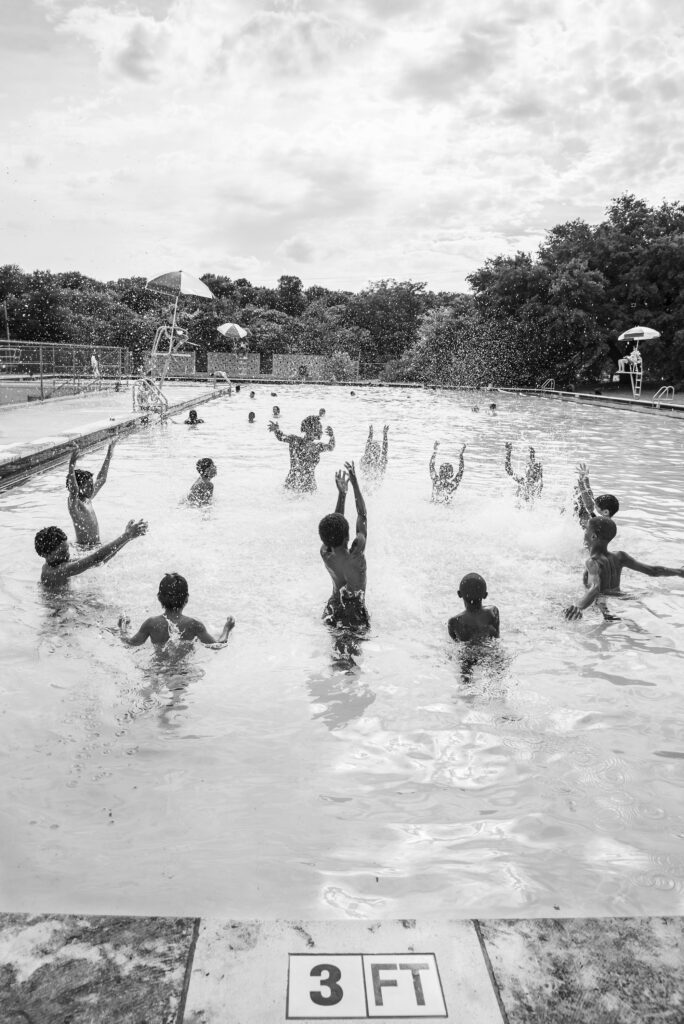Written by Cathy Centeno Navarro
The Art Galleries at Austin Community College hosted two TAG Tuesday sessions in March 2023, in which ACC Photography Professors and exhibition co-curators Maja Buck and Bret Brookshire lead discussions about the works displayed in Food Shelter Water: Projects by Four Texas Photographers
This exhibition features work by four Texas-based photographers, who address themes related to our most basic human needs. Barriers to these resources reflect the baseline issues surrounding social justice and equity within American society and around the world (noted from Food Shelter Water exhibition webpage).
Exploring the Artwork (Part One) with Photography Professor Maja Buck
During the March 7 TAG Tuesday session, Professor Maja Buck focused on Jamie Robertson and Stephanie Duprie Routh’s works. She began the session by directing the audience to look slowly through Robertson’s photographs, which recognize the legacy of Black land ownership in East Texas. The images convey Robertson’s family’s lived experience on a group of adjacent properties, which they have owned for over 130 years.
Professor Buck then led a discussion about how the audience members see photographs in relation to the themes of the exhibition: food, shelter, and water. Both the audience and Buck described that Robertson’s photographs relate closely to the idea of “shelter” – which is represented both through images of houses and through moments of close community.
She explained, “the idea of shelter isn’t always quite literal.” The photographs display a literal interpretation of a house, while also “embodying a family, ancestry, sense of place, and space, not just the physical location, but within family members as well.”
Professor Buck then directed the audience’s attention to Duprie Routh’s photographs, which document her ten-day trip up the Nile River in Egypt and all the intimate moments of sailing, farming, and fishing Duprie Routh encountered on this journey. The audience pointed out how “water” is the main character in the photographs. In the images, water is captured being used in various ways people are swimming, working, and using water for transportation.
After opening up for audience questions, Professor Buck was asked what she looked for as a curator when choosing the photographs between the two artists. Her approach was choosing strong photographs that stood out, and helped create an overarching narrative. She explained,“[the photographs] have to gel aesthetically and [have] a strong story.”
Exploring the Artwork (Part Two) with Photography Professor Bret Brookshire
Professor Bret Brookshire led the March 28 TAG Tuesday session and discussed Cindy Elizabeth and Veronica G. Cárdenas’ photographs. He began the session by discussing the two sets of photographs as a whole, asking the audience how the photographs relate to the exhibition’s themes of food, shelter, and water.

Verónica G. Cárdenas, Migrants, mostly Haitians, cross back and forth on the Rio Grande to Ciudad Acuña, México and Del Rio, Texas, 2021, digital photograph
The audience agreed Elizabeth’s work centered around the theme of water, while Cárdenas’ work focused on shelter. Professor Brookshire explained that in Cárdenas’ photographs, many of the subjects are migrants – all of whom may be living without a stable physical home. However, when provided with no shelter or home, people often gather together in order to protect – or shelter – one another.
Professor Brookshire followed by explaining how the theme of shelter and community also play a subtle yet powerful part in Elizabeth’s work. An audience member commented on the connection they recognized in his point on “community.” Elizabeth’s photographs show a safe place for a local community, while Cárdenas’ photographs show a traveling community, and the shelter found in gathering with each other.
Brookshire then directed the attention to Elizabeth’s work, which displays a family-oriented aquatic performance at Givens Pool in East Austin, inspired by the genres of Afro-futurism and Science Fiction.
He tells the audience that “Afro-futurism” stood out when reading the paragraph next to Elizabeth’s work. Afro-futurism is visual art and literature inspired by Black pride and centers around Black culture, self-determination, and resilience. While Elizabeth’s photographs aren’t specifically futuristic, Brookshire interprets Elizabeth’s work as telling a story of a neighborhood over time, inhabiting space that blends the past, present, and future.
“If your community is bound together by stories – [specifically] stories of your foundations – I think that’s also shelter. [You’re] sheltered by [your] story.”
Professor Brookshire then moved on to Cárdenas’ work, which documents the realities of migration and seeking asylum at the southern border of the U.S. As a photographer himself, Brookshire complimented Cárdenas and their photographic ability. He shared how Cárdenas paid close attention to the quiet moments – acknowledging their choice of what to photograph. They could have easily taken pictures when chaos struck. Instead, Brookshire admires Cárdenas’ choice in photographing the “human moments” when the atmosphere was quiet.

Verónica G. Cárdenas, Jeancarlos from Guatemala, age 6, at a makeshift encampment where he has been waiting with his mother and brother to seek asylum in the U.S. , in Tijuana, México, 2018, digital photograph
Food Shelter Water: Projects by Four Texas Photographers is on view March 7 – June 29 in Gallery 4000 (HLC 4.2105) on ACC Highland Campus. For more information on this exhibition and the four participating artists, visit the Food Shelter Water webpage.





Recent Comments